You should be fine. Dissecting a failure mode is always challenging (but interesting) and to me, high frequency instability in the amp looks a number one suspect. I can't see any other way that you could generate the voltage needed across that 15 ohm to cause it to fail as you describe.
You should be fine. Dissecting a failure mode is always challenging (but interesting) and to me, high frequency instability in the amp looks a number one suspect. I can't see any other way that you could generate the voltage needed across that 15 ohm to cause it to fail as you describe.
Thanks for the reassurance..... I'll check that all is OK before reinstalling the crossovers in the cabinets... Cheers
This is probably the Saturday Night Party syndrome.
Some drunk turns the amp up too high and the 6R tweeter blows. Now the speaker has no top end so he turns it up even more into clipping, which directs huge power (like 20W) at the tweeter crossover circuit.
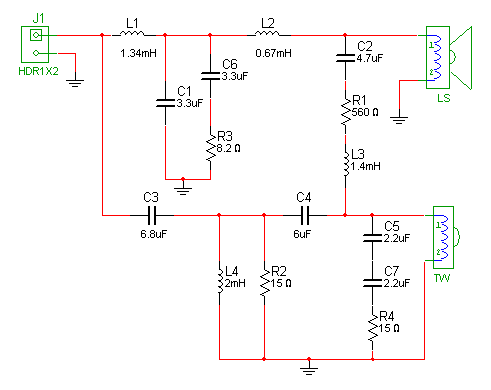
This all goes into the 7W 15R resistor, rather than being shared with the 6R tweeter. Which burns. Often damages the amp too.
Better designs have a resistor at the input, which can help. But clipping is never good. A tweeter section rarely takes more than 5W in normal use.
Some drunk turns the amp up too high and the 6R tweeter blows. Now the speaker has no top end so he turns it up even more into clipping, which directs huge power (like 20W) at the tweeter crossover circuit.

This all goes into the 7W 15R resistor, rather than being shared with the 6R tweeter. Which burns. Often damages the amp too.
Better designs have a resistor at the input, which can help. But clipping is never good. A tweeter section rarely takes more than 5W in normal use.
This is probably the Saturday Night Party syndrome.
Some drunk turns the amp up too high and the 6R tweeter blows. .........
These speakers were purchased by my parents when they were in their late 70's and the picture you paint made me smile....
I think the problem occurred when these speakers were passed on to me and where used for a time as test speakers for amplifiers I was renovating. One particular amplifier, an Onkyo, had major issues with overheating on one channel - probably due to oscillation (?) and this could have caused the damage.
It was my fault for using good speakers in this role... I no longer do this!
I will also mention that my Heybrook crossover circuits have a couple of different component values to the one you issued. C6 in mine is 10mfd, not 3.3 and C2 4mfd, not 4.7
Thanks
Last edited:
Glad to see this thread is still having some attention!
I didn't respond to an earlier question about whether we measured or just listened during the development process. Here's the answer:
Most of the original design was by listening only. We knew the sound that we wanted (I'd worked in retail hi-fi for nearly a decade and was reviewing for Hi-Fi magazines at the time while Stuart had a pair of Celestion Ditton 15s that he needed to 'upgrade').
We started with Richard Allan drivers but couldn't get anywhere near the sound we needed to gravitated to Audax which were then making a superb treble dome, the HD12x9. We wanted to produce a small speaker, so a 6 inch bextrene coned driver was chosen from the Audax stable to marry to it.
As it happens that was a fortuitous combination and, put in a 15mm chipboard cabinet with a lining of 7mm bitumen pads, reflex tuned gave a good starting point.
Now we wanted the port out of the way, so we put it round the back where its 'chuffing' was less audible and partially solved the airflow problem by use of a foam ring around the exit.
Then allow about 12 months of listening, starting with a basic 3rd order Butterworth and adding elements to it to 'tame' some of the wayward driver characteristics (Bextrene has a peaky, nasal quality to the midrange which needs a lot of control) and we were getting close.
However we couldn't make the breakthrough we needed. We did some talking to the UK Audax distributor and he suggested we use his Bruel and Kjaer measurement equipment at his office. So off we went and got them measured and they weren't too far off a flat response, as it happens (quite amazing for something developed by ear). A couple of tweaks were suggested to flatten some peaks in the response and we returned home.
On the basis of the measurements we got on a lot faster (should have done it earlier really!). Six months later we were ready for production.
Shortly afterwards we were able to buy our own B&K equipment and this made future model development a lot faster as we were able to iterate between listening and testing.
So, all in all, 2 years spent developing the HB2 and well worth it IMO!
I didn't respond to an earlier question about whether we measured or just listened during the development process. Here's the answer:
Most of the original design was by listening only. We knew the sound that we wanted (I'd worked in retail hi-fi for nearly a decade and was reviewing for Hi-Fi magazines at the time while Stuart had a pair of Celestion Ditton 15s that he needed to 'upgrade').
We started with Richard Allan drivers but couldn't get anywhere near the sound we needed to gravitated to Audax which were then making a superb treble dome, the HD12x9. We wanted to produce a small speaker, so a 6 inch bextrene coned driver was chosen from the Audax stable to marry to it.
As it happens that was a fortuitous combination and, put in a 15mm chipboard cabinet with a lining of 7mm bitumen pads, reflex tuned gave a good starting point.
Now we wanted the port out of the way, so we put it round the back where its 'chuffing' was less audible and partially solved the airflow problem by use of a foam ring around the exit.
Then allow about 12 months of listening, starting with a basic 3rd order Butterworth and adding elements to it to 'tame' some of the wayward driver characteristics (Bextrene has a peaky, nasal quality to the midrange which needs a lot of control) and we were getting close.
However we couldn't make the breakthrough we needed. We did some talking to the UK Audax distributor and he suggested we use his Bruel and Kjaer measurement equipment at his office. So off we went and got them measured and they weren't too far off a flat response, as it happens (quite amazing for something developed by ear). A couple of tweaks were suggested to flatten some peaks in the response and we returned home.
On the basis of the measurements we got on a lot faster (should have done it earlier really!). Six months later we were ready for production.
Shortly afterwards we were able to buy our own B&K equipment and this made future model development a lot faster as we were able to iterate between listening and testing.
So, all in all, 2 years spent developing the HB2 and well worth it IMO!
Ahh nostalgia ..don't mean to go off -topic but just spotted this thread and the posts by some of the Heybrook designers/builders. Livlng just " up the road " from their old factory it was only natural that a pair of HB 1's formed part of my very first " proper" system . I also had a pair of 0. 5 's and a set of their
" strange " looking ( for the time ) stands.
So a big thanks to all the ex-Heybrook guys for opening my eyes , or more accurately ears, to the sound of " real " music all those years ago .
.
" strange " looking ( for the time ) stands.
So a big thanks to all the ex-Heybrook guys for opening my eyes , or more accurately ears, to the sound of " real " music all those years ago
Hi,
All I can glean from this thread is design at the time was an utter farce.
Including features "that sound good" without understanding them, and
they still don't, is not engineering, its utter snake oil. YMMV but the
claims are farcical. like only the totally incorrect type of inductor
sounded right in the pointless additional "wonder circuit".
You have to wonder what they were smoking IMO.
Thankfully nothing modern contains such nonsense.
rgds, sreten.
All I can glean from this thread is design at the time was an utter farce.
Including features "that sound good" without understanding them, and
they still don't, is not engineering, its utter snake oil. YMMV but the
claims are farcical. like only the totally incorrect type of inductor
sounded right in the pointless additional "wonder circuit".
You have to wonder what they were smoking IMO.
Thankfully nothing modern contains such nonsense.
rgds, sreten.
Quite honestly, sreten, my grandma used to say to me that if you can't say anything nice about somebody, it's probably better to say nothing at all. 
Peter Comeau is possibly the most successful speaker designer in the UK.
After an allegedly shaky start with Heybrook he has gone onto designing great stuff for World Audio, Wharfedale and Quad. Admittedly owned by Chinese Companies who have bought into the UK's natural talent for design.
TBH, I don't know why we have abandoned the whole process. But we shall arise again.
Peter Comeau is possibly the most successful speaker designer in the UK.
After an allegedly shaky start with Heybrook he has gone onto designing great stuff for World Audio, Wharfedale and Quad. Admittedly owned by Chinese Companies who have bought into the UK's natural talent for design.
TBH, I don't know why we have abandoned the whole process. But we shall arise again.
Hi,
You can have your opinion about PJC and so can I.
I know he deliberately misvoiced speakers at the
behest of one of the manufacturer he worked for,
(he himself said so), and as a veteran is a master
of hifi hype doublespeak, which is British tradition.
Check out Rega's site for more waffle than you can toast.
He is successful, but he is not a great designer.
Good line in waffle, like any ex hifi journalist.
rgds, sreten.
You can have your opinion about PJC and so can I.
I know he deliberately misvoiced speakers at the
behest of one of the manufacturer he worked for,
(he himself said so), and as a veteran is a master
of hifi hype doublespeak, which is British tradition.
Check out Rega's site for more waffle than you can toast.
He is successful, but he is not a great designer.
Good line in waffle, like any ex hifi journalist.
rgds, sreten.
I don't know about anyone else but I listen to music because I enjoy it and I definitely enjoy listening through my HB2s irrespective of whether they're correctly engineered. That's not snake oil, that's reality. Reality definitely matters.
I don't suppose anyone ever got an answer to what drivers would be appropriate replacements for the woofers? The cardboard bit between the rubber surround and the speaker chassis is falling apart on mine and it sounds like there's a bit of internal rubbing. I can't find anything to suggest what might work as a replacement.
I don't suppose anyone ever got an answer to what drivers would be appropriate replacements for the woofers? The cardboard bit between the rubber surround and the speaker chassis is falling apart on mine and it sounds like there's a bit of internal rubbing. I can't find anything to suggest what might work as a replacement.
Wilmslow Audio sell an HB2 "replica" kit based on the original which uses a Monacor SPH-165 woofer. This unit may be a suitable replacement. Could be worth talking to the people at Wilmslow Audio?
WA HB2 Loudspeaker
WA HB2 Loudspeaker
There aren't many drivers of that type around now. Probably the 'best' option would be to get a semi-custom pair of drivers built by Audiotechnology, but that comes with a big price tag. For smaller coin, assuming you stil want a polypropylene cone, then the Monacor, or something like the SB17MFC35-8 or Seas U18RNX/P would be closest. Not 'drop-in' though; you'll need to redesign the crossover.
...... Not 'drop-in' though; you'll need to redesign the crossover.
Not sure how you would go about tweaking the idiosyncratic HB2 crossover - perhaps unnecessary anyway?
Depends on exactly what you're referring to. Providing the replacement drivers have the same frequency & impedance responses (and are the same physical depth), then the crossover could remain as-is. If not, which is 99.99% certain, it would need changing. That little bridging circuit would probably be the first thing to go, since as Peter himself noted on this thread, we have easy access to modelling software now that was unavailable to him in the late 1970s, and that should allow you to track similar targets with less complexity. Basically, whole new XO, aka a whole new speaker.
If you can get the woofers rebuilt properly, then I'd be more inclined to do that. It's a classic speaker, and other than restoring, I usually tend to think they're better off left that way.
If you can get the woofers rebuilt properly, then I'd be more inclined to do that. It's a classic speaker, and other than restoring, I usually tend to think they're better off left that way.
Last edited:
Wilmslow Audio sell an HB2 "replica" kit based on the original which uses a Monacor SPH-165 woofer. This unit may be a suitable replacement. Could be worth talking to the people at Wilmslow Audio?
WA HB2 Loudspeaker
HB2 Replica? Don't make me laugh. This is as close to a 'replica' as a Ford Mondeo is to a Jaguar - they both look similar but that's as far as it goes.
I don't blame Wilmslow for trying to hoist some sales on the basis of what turned out to be a classic design, but I wish they'd done it better. Also the picture of the WA-HB2 clearly shows a bass unit with foam surround and phase plug, whereas the Monacor SH-165 bears no resemblance at all!
Look, the principle sound of any loudspeaker is based around the character of its drive units and the crossover that combines them. Change anything and you'll get a completely different sound.
The bextrene cone in the Audax HD17B25H may not be everybody's idea of a great midrange drver and, in fact, we chose it because of its oustanding bass response in a small enclosure and then dealt with the midrange problems in the crossover.
So, if you simply replace the bass unit with something entirely different, like the Monacor, it simply isn't going to work. You might as well start from scratch and design something new.
I've currently got a pair of HB2s, one of which needs a new bass unit. I'm trying to find someone who can repair the bass unit, which has rubbing voice coil, and will post again if I find a solution.
Oh, nice to hear from you Peter!
I do enjoy a good speaker, and this is a good modern interpretation of the plastic 6" plus 1" tweeter, IMO. Reviving the "Chartwell" name to a BBC sort of thing.
Chartwell LS6 - Graham Audio - British manufacturers of high quality loudspeaker systems
I bet they are not a million miles from your ideas.
I do enjoy a good speaker, and this is a good modern interpretation of the plastic 6" plus 1" tweeter, IMO. Reviving the "Chartwell" name to a BBC sort of thing.
Chartwell LS6 - Graham Audio - British manufacturers of high quality loudspeaker systems
I bet they are not a million miles from your ideas.
Hi, I'm coming a little late to this party
Hello Peter.
You're coming late? Ha, I'm only now coming along some five years late.
Thanks to you and Shane for the history lesson. I have owned an original pair of HB2 since new back in 1986 (dB Audio, Berkeley, Ca USA). I had a TT2 back in those days as well.
I have downsized my system significantly in the past year. Out went the Maggie 3.5r with Rowland 7 and Stan Klyne SK5. Returning to action are my HB2 speakers on original (US)stands. The grills are long gone but the speakers still sound wonderfully coherent and correct. My question, any idea where I can obtain NOS drivers? Also, is their a specific density of foam you used where the port tube connects to the speaker's back wall?
Michael Bicak who still love his HB2s in Redmond, WA. btw: we sold a LOT of HB2 and TT2 products at dB Audio in '85 and '86.
Last edited by a moderator:
Things got very heated here, back in the day! 
I was just reminding myself what this thread was about...
The mysterious "Enigma" LCR.
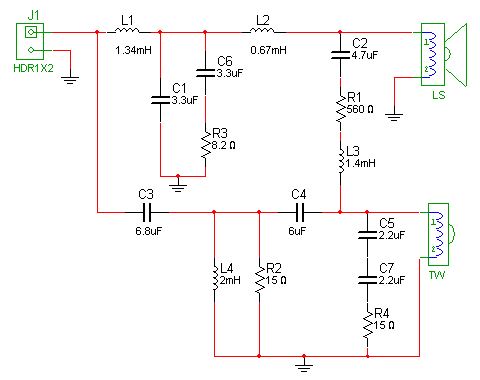
Most of the circuit is fairly standard for the time, and KEF used something like it in the 8" bextrene Cadenza:
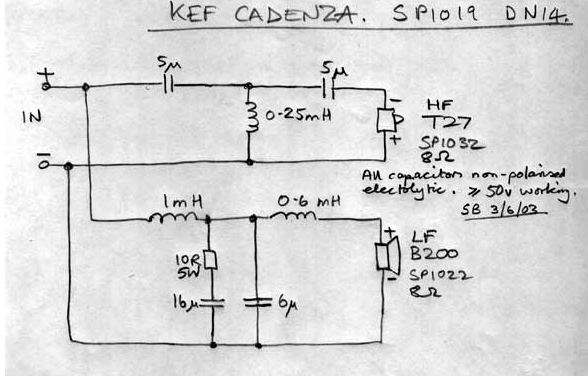
I did run a sim of the circuit, although I can't remember if I used 0.2 or 2mH in the tweeter circuit. Looks like the bass circuit is mostly bafflestep and 3rd order rolloff. So my guess is almost any well behaved polycone should do the right things.
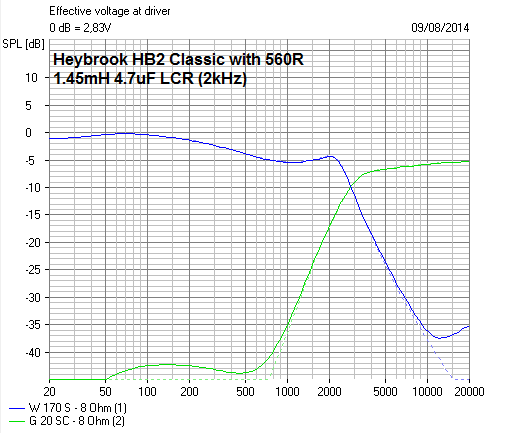
Peter Comeau might add something.
I was just reminding myself what this thread was about...
The mysterious "Enigma" LCR.
Most of the circuit is fairly standard for the time, and KEF used something like it in the 8" bextrene Cadenza:
I did run a sim of the circuit, although I can't remember if I used 0.2 or 2mH in the tweeter circuit. Looks like the bass circuit is mostly bafflestep and 3rd order rolloff. So my guess is almost any well behaved polycone should do the right things.
Peter Comeau might add something.
Thanks, Steve.
You're probably right. I am always dubious about switching drivers, however, as cone mass, voice coil winding, spider, basket material, and surround can affect what, on spec appears to be a "good as original" replacement. Any thoughts?
btw: I'm trying to find my copy of Audio Cyclopeida. I recall a time correction filter design for x-overs, within. I had a high-end car stereo company in the late '70s and early '80s. We were nuts but attempted to build quality audio systems way back when, including from-scratch x-overs and enclosures. I recall my designer using this filter to try and time the rear and front drivers for the car driver's head position. It was not beyond the pale for us to install a Nagra IV-S as the source. It was that or cassette back then, yes? We mostly used Audax drivers sourced from Just Speakers in San Francisco. When our chosen driver was not in stock we would sometimes change the driver but always had to fiddle with the x-over as I recall. I learned a lot back in those days. Sadly, at 67 I've forgotten a lot, too; in fact, I forget more every day than I'll ever learn again
You're probably right. I am always dubious about switching drivers, however, as cone mass, voice coil winding, spider, basket material, and surround can affect what, on spec appears to be a "good as original" replacement. Any thoughts?
btw: I'm trying to find my copy of Audio Cyclopeida. I recall a time correction filter design for x-overs, within. I had a high-end car stereo company in the late '70s and early '80s. We were nuts but attempted to build quality audio systems way back when, including from-scratch x-overs and enclosures. I recall my designer using this filter to try and time the rear and front drivers for the car driver's head position. It was not beyond the pale for us to install a Nagra IV-S as the source. It was that or cassette back then, yes? We mostly used Audax drivers sourced from Just Speakers in San Francisco. When our chosen driver was not in stock we would sometimes change the driver but always had to fiddle with the x-over as I recall. I learned a lot back in those days. Sadly, at 67 I've forgotten a lot, too; in fact, I forget more every day than I'll ever learn again
Last edited by a moderator:
You are probably thinking of a "ladder network" for tweeter time delay. Zaph used it in the ZD5 tweeter circuit. We used to call them Group Delay Equalizers when I did telecoms.
Zaph|Audio - ZD5 - Scan Speak 15W8530K00 and Vifa XT25
Personally I prefer a 3rd or 4th order electrical tweeter, which does much the same thing IMO:
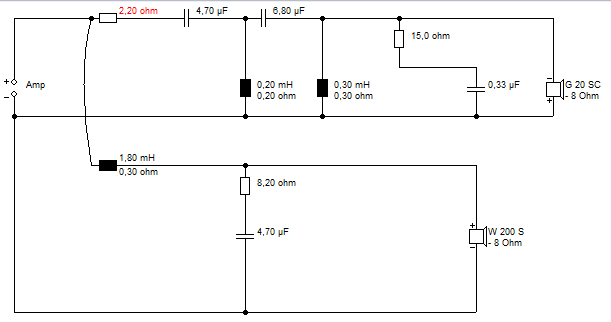
I can only second-guess Michael Chua here, but I'd suppose he uses a ladder network in his Cardinal-TA design. He'll send you the circuit if you email him. The Peerless 830874 is a well liked and bassy polycone.
We see people agonising over replacement drivers and spending far too much on eBay, but really I don't think it's hard to try a well-behaved substitute. Actually, the art of polycones has come on. Alan Shaw at Harbeth has designed his own far more ideal version of the Mineral Filled Polycone:
YouTube
Zaph|Audio - ZD5 - Scan Speak 15W8530K00 and Vifa XT25
Personally I prefer a 3rd or 4th order electrical tweeter, which does much the same thing IMO:
I can only second-guess Michael Chua here, but I'd suppose he uses a ladder network in his Cardinal-TA design. He'll send you the circuit if you email him. The Peerless 830874 is a well liked and bassy polycone.
We see people agonising over replacement drivers and spending far too much on eBay, but really I don't think it's hard to try a well-behaved substitute. Actually, the art of polycones has come on. Alan Shaw at Harbeth has designed his own far more ideal version of the Mineral Filled Polycone:
YouTube
- Home
- Loudspeakers
- Multi-Way
- Q on Heybrook HB2 XO